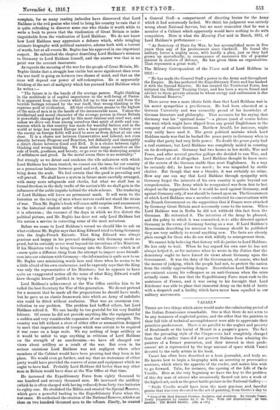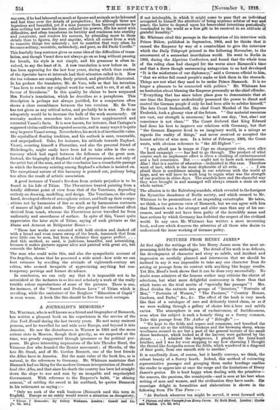VASARL*
THERE are two things which alone would make the culminating period of the Italian Renaissance remarkable. One is that there do not seem to be any instances of neglected genius, and the other that the painters in their full tido of technical accomplishment wore able to appreciate their primitive predecessors. There is no parallel to the neglect and poverty of Rembrandt or the burial of Mozart in a pauper's grave. Tho fact that the prevailing style of the Cinquocento had completely changed from that of earlier times d:d not prevent Italians from admiring the painters of a former generation, and their interest in their prede- cessors' art is represented by the large amount of space which Vessel devoted to the early artists in his book.
Vasari has often been described al a born journalist, and truly so. He knows how to begin a biography with an arresting or provocative sentence, which whets the appetite of the reader, and makes him wish to go forward. Take, for instance, the opening of the Life of Paolo Uccello. Here at the very begininng wo have the key to the problem of this dry man of science who occasionally flamed out into a work of the highest art, such as the great battle picture in the National Gallery:—
"Paolo Uccello would have been the most gracious and fanciful genius that was ever devoted to the art of painting, from Giotto's day to
• Lira of the East Eminent Pat:dere, Sculptors, and Architect*. By Giorgio Waged. Newly Translated by Gaston du C. de fete. With 500 illustrations. 10 vols. leaden : The Medici flocietY. 126s. a our own, if he had laboured as much at figures and animals as he laboured and lost time over the details of perspective ; for although these are ingenious and beautiful, yet if a man pursues them beyond measure he does nothing but waste his time, exhaust his powers, fills his mind with diffioulties, and often transforms its fertility and readiness into sterility and constraint, and renders his manner, by attending more to these details than to figures, dry and angular, which all comes from a wish to examine things too minutely ; not to mention that very often he becomes solitary, eccentric, melancholy, and poor, as did Paolo Uccello." This fearfully long sentence gives us some idea of the difficulties of trans- lation, and though Vasari does not always go on so long without pausing for breath, his style is not simple, and his grammar is often in- volved, to say the least of it. A new translation is now before us. It has been appearing for the last four years, during which time readers of the Spectator have at intervals had their attention called to it. Now the ten volumes are complete, finely printed, and plentifully illustrated. In his preface the translator, Mr. de Vero, tells us that his intention " has been to render my original word for word, and to err, if at all, in favour of literalness." In this quality he claims to have surpassed Mrs. Foster's translation, which he describes as a paraphrase. This description is perhaps not always justified, for a comparison often shows a close resemblance between the two versions. Mr. de Vera has not given us any critical notes, and probably he is wise. To do so adequately would be to increase the bulk of the work enormously. Of necessity modern researches into archives have supplemented and corrected Vasari's facts. It is now known, for instance, that Castagno's supposed victim outlived his reputed assassin, and in many ways it is quite easy to prove Vasari wrong. Nevertheless, his work is of inestimable value. He crystallized floating tradition, and his outlook is sane, reasonable, and unprejudiced. Take, for instance, his attitude towards Raphael. Vasari, counting himself a Florentine, and also the personal friend of Michelangelo, might easily have been led to take sides in the con- troversy whioh had raged between the followers of the great men. Instead, the biography of Raphael is full of generous praise, not only of the artist but of the man, and at the conclusion has a remarkable passage in which the harmony existing among Raphael's scholars is insisted on. The exceptional nature of this harmony is pointed out, jealousy being too often the result of artistic association.
A good instance of Vasari's freedom from artistic prejudice is to bo found in his Life of Titian. The Florentines treated painting from a totally different point of view from that of the Venetians, depending entirely on drawing, modelling, and design. The Venetians, on the other hand, developed effects of atmcspheric colour, and built up their compo- , sitions not by harmonies of line so much as by harmonious contrasts of masses of light and shade. They also grasped the emotional effect derived from touch, whereas the Florentines never travelled far from uniformity and smoothness of surface. In spite of this, Vasari quite appreciates the later style of Titian, saying of such pictures as the Diana and Actaeon at Bridgwater House :—
" These last works are executed with bold strokes and dashed off with a broad and even coarse sweep of the brush, inasmuch that from near little can be seen, but from a distance they appear perfect. . . . And this method, so used, is judicious, beautiful, and astonishing, because it makes pictures appear alive and painted with great art, but conceals the labour."
The man who could write this, and also the sympathetic account of Fra Angelico, shows that he possessed a wide mind—how wide we can best estimate by recalling the attitude of eighteenth-century art critics, who seemed incapable of appreoiating anything but con- temporary periwigs and former decadence.
In conclusion, we can only say that it is impossible not to be astonished at the inclusion in so fine and scholarly a work of the really terrible colour reproductions of some of the pictures. There is one, for instance, of the " Sacred and Profane Love " of Titian which is revolting, while the caricature of the Borgheso " Education of Cupid " is even worse. A book like this should be free from such outrages.















































 Previous page
Previous page